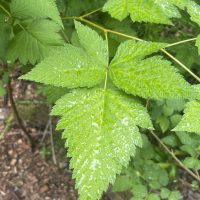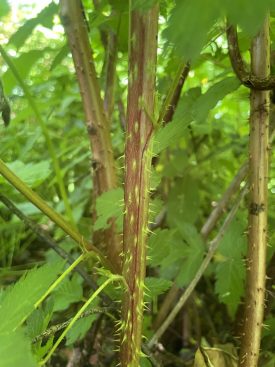June 2021 Plant Profile: Salmonberry

As we look forward to the warmth of the summer, let’s take a moment to appreciate one of the first berries that ripens in our region – salmonberry. The scientific name is Rubus spectabilis and is appropriately named for its showy flowers and berries. The genus Rubus is derived from ruber, the Latin word for red, while spectabilis is Latin for spectacular, notable, or showy. One of the first plants to bloom in the early spring, salmonberry boasts beautiful pink flowers which are representative of the Rose family with many stamens centered in a circle of 5 pink petals. In early summer these ripen into berries that range in color from yellow to red. Both the flowers and the fruits are an important food source for wildlife and people.

The leaves of salmonberry are composed of 3 sharply-toothed leaflets while the stems are a bright vibrant green which become woody with age. Typically, the stems are covered in fine prickles and are not as densely armed as other members of the genus Rubus, such as blackberry, which makes this a more enjoyable plant to harvest. Reviews of the berries range from “tastes-like-grass” to “tasty,” but if you ask me, I say they live up to their namesake of spectabilis.

In addition to providing food, salmonberry is great for providing soil stability and is a common pick for riparian and wetland restoration projects in the Puget Lowlands region. Salmonberry is easy to transplant and propagate from cuttings and is well adapted to disturbed or eroded areas. Its ability to form thickets is also great for restoring disturbed areas and providing habitat for birds and other wildlife. For this reason, care should be taken if you’d like to plant it in your own garden as it can easily escape the spot you set out for it.
Salmonberry is commonly found in moist forests, along streams and rivers, bogs and shorelines. In the Arboretum you can find it in many locations typically in wet areas along the Arboretum Creek or areas with native vegetation. In addition, there are a few plantings of a variety with double flowers, Rubus spectabilis ‘Olympic Double’ (synonymous with ‘Gun Hildi’ and ‘Flore Pleno’).
Common Name: Salmonberry
Scientific Name: Rubus spectabilis
Location: Throughout the Arboretum, especially in moist areas along the creek and areas with native vegetation.
Origin: Endemic to the Pacific Northwest extending north into Alaska and Canada, and south to Washington, Idaho, Oregon, and California.
Height and Spread: 3 – 12 feet, rhizomatous, typically forms dense thickets.
Bloom Time: February – May
Fruit Ripens: May – July